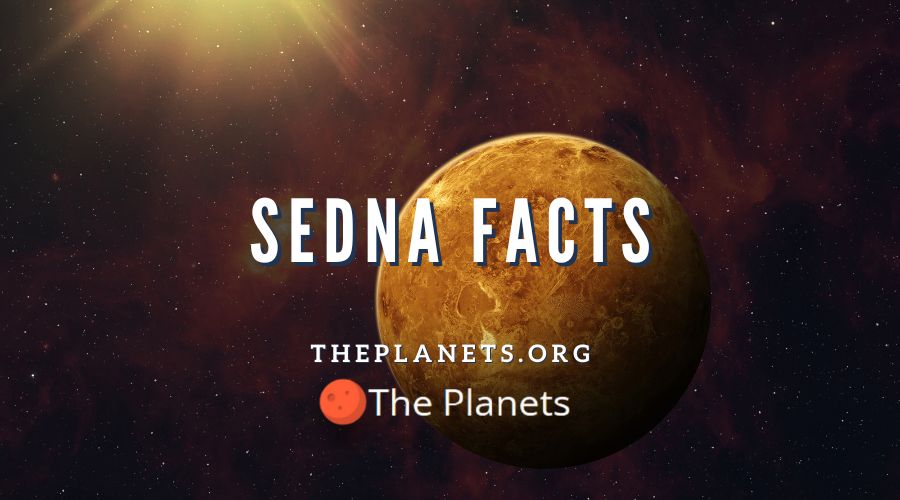
Discovery of Sedna
On November 14, 2003, Michael Brown, David Rabinowitz, and Chad Trujillo discovered the distant planetoid at the Palomar Observatory.
At the time of its discovery, it was the coldest and most distant known object in the solar system. With this in mind, scientists decided to name the minor planet Sedna, after the Inuit goddess of the sea who, according to legend, lives in the depths of the Arctic Ocean.
A slight controversy arose in the science community when Sedna’s name became public before the International Astronomical Union (IAU) gave it an official number. However, no other names were put forward for consideration, and the IAU made the name official in September of 2004.
The Sedna controversy also led to the organization ruling that, when discoveries of extraordinary interest have been made, a name can be submitted for approval before they have assigned a number to the object.
Location of Sedna
Sedna resides beyond the Kuiper Belt in what is theorized to be the Oort-Cloud; an area of particles thought to be left over from the birth of the galaxy.
With its rounded shape, the Oort-Cloud has two parts; the outer cloud and the inner cloud. Scientists believe that Sedna makes its home in the inner cloud.
Characteristics of Sedna
Size
Estimated to be between 800 and 1100 miles (≈1300-1770 km) in diameter, Sedna is only 75% the size of Pluto. Its exact mass remains unknown, as the planetoid lacks a moon or other nearby orbiting body that is needed to complete this calculation.
Temperature
Due to its distance from the sun, the minor planet is extremely cold. Scientists believe that temperatures never rise above -400°F (240°C).
Surface
While it is not possible to say what Sedna’s surface is like exactly, scientists have proven that nitrogen, methane, and water ice are among its makeup.
The minor planet’s striking red color is similar to that of Mars.
Orbit
While most known planets in the solar system follow a sphere-shaped orbit, Sedna is special in that its orbit follows an elliptical path.
At times, this unique journey takes the space body as far as 84 billion miles away from the sun; that’s 900 times the distance Earth is from its home star. Even when Sedna makes its closest pass to Earth, it is still further away than Pluto, making it a very distant neighbor indeed.
While scientists haven’t proven exactly why Sedna’s orbit is so oddly shaped, they do have a few ideas. One popular theory is that when the solar system was forming, traveling space objects pulled the minor planet with their gravity and large, but currently undiscovered, space bodies now hold Sedna in its current orbit.
The planetoid takes roughly 10,500 years to complete one journey around the sun. In fact, the last time Sedna was anywhere near earth was about 11,700 years, when the Earth was just coming out of its latest ice age.
Classification
Sedna is categorized as a minor planet since its orbit takes it directly around the sun.
The distant world is up for consideration as a dwarf planet, however for this to happen, scientists would have to prove that the planetoid is in hydrostatic equilibrium. That is to say; there is a balance of the forces that press downwards and upwards against the object. Finding out if this is the case on Sedna will require scientists to wait for more advanced technology to be made available.
Moon
At this point, there have been no moons discovered orbiting Sedna.
When first observed, scientists believed that the minor planet had a very slow rotation, averaging one spin every 20 days. This slow speed suggested that Sedna had to have a moon whose gravity was affecting it. Much to everyone’s confusion, however, no moon could be located and experts were baffled.
Through further studies, scientists proved that the planet’s rotation is actually closer to one spin every 10 hours. This new conclusion suggests that Sedna doesn’t necessarily have any moons surrounding it and, to date, astronomers haven’t witnessed any astronomical companions orbiting the minor planet.
Exploration
At the time of this writing, NASA has announced no plans for a research mission to this distant world. However, the planet is listed on their Solar System Exploration website, suggesting that future missions are in the realm of possibility.
Ideally, plans to conduct a flyby with a satellite would take place between 2075–2076, when Sedna will be as close to the sun as possible.
Conclusion
In many ways, the distant Sedna remains a mystery. However, its discovery has opened new possibilities as to what lies at the far reaches of our solar system. In the decades to come, more information will surely come to light about this strange minor planet that makes its home so far away from Earth.
Sedna Facts
Date of discovery: November 14, 2003
Discovered by: Michael Brown, David Rabinowitz, and Chad Trujillo
Name: (90377) Sedna
Alternative name: 2003 VB12
Classification: Minor planet
Minor planet category: trans-Neptunian object
detached object sednoid
Mass: Unknown
Diameter: 800 to 1100 miles (≈1300-1770 km)
Temperature: -400°F (240°C)
Rotation: Once every 10.273 hours
Orbit cycle: 10,500 years
Location: Inner Oort-Cloud
Distance from the Sun: 7 billion miles – 84 billion miles ( ≈11 billion km-130 billion km)
Moon(s): None discovered